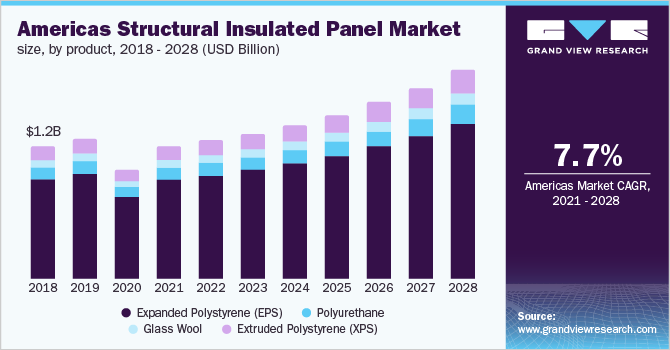Americas Structural Insulated Panel Industry Overview
The Americas structural insulated panel market size is expected to reach USD 4.27 billion by 2028 registering a CAGR of 7.7% over the forecast period, according to a new report by Grand View Research, Inc. Favorable regulations and rising adoption of various green building standards are some of the key factors driving the market growth. Rising spending in the construction sector in North America due to the increasing government initiatives for the modernization of the infrastructure and energy-efficient homes and the rising number of green buildings in the U.S. and Canada is projected to drive the product demand.

Many market players are engaged in manufacturing and supplying raw materials and creating strong competition, affecting the overall pricing of the structural insulated panels (SIPs). The presence of several raw material manufacturers in the market results in low prices of these materials. Some of the key companies are also engaged in installation through their network of certified contractors and installers. Investments, new product development, and regional expansion are the key strategies adopted by the market players to strengthen their industry position. However, fluctuations in raw material prices and the adverse impact of the Covid-19 pandemic are expected to emerge as key concerns for the industry participants.
Americas Structural Insulated Panel Market Segmentation
Grand View Research has segmented the Americas structural insulated panel market on the basis of product, application, and region:
Based on the Product Insights, the market is segmented into Expanded Polystyrene (EPS), Polyurethane, Glass Wool, and Extruded Polystyrene (XPS).
- The EPS product segment led the market in 2020 and accounted for more than 76% share of the overall revenue.
- The segment will grow further at a steady CAGR from 2021 to 2028 due to rising demand for EPS in the building & construction industry on account of its superior properties, such as enhanced sound absorption and low weight & cost.
- SIPs are used to construct buildings to decrease the overall energy consumption of the building and regulate the temperature in the interiors, thereby making the building more sustainable.
Based on the Application Insights, the market is segmented into Walls & Floors, Roofs, and Cold Storage.
- The walls and floors application segment led the market and accounted for over 45% of the total revenue share in 2020.
- The segment will expand further at the fastest CAGR from 2021 to 2028 owing to the burgeoning demand for Structural Insulated Panels (SIPs) and growing investments for the establishment of commercial structures and institutional buildings, such as schools, hospitals, theaters, malls, and hotels.
- Temperature regulated by insulated roofs leads to improvement in buildings’ energy efficiency through a reduction in usage of air conditioning systems and heaters. Such benefits are projected to drive the market growth over the forecast period.
Americas SIP Regional Outlook
- North America
- Central & South America
Key Companies Profile & Market Share Insights
The market is highly competitive owing to the presence of both regional and multinational players. New product development and competitive pricing are some of the manufacturers’ key focus areas to strengthen their industry positions. In addition, many companies offer additional services, such as engineering & technical advisory and installation assistance, to enhance their customer base. Major players invest in research and development activities and continuously launch new products to gain a competitive edge.
Some prominent players in the Americas structural insulated panel market include:
- Kingspan Group
- Metl-Span
- Owens Corning
- Metecno Group
- KPS Global
- Isopan
- PFB Corporation
- All Weather Insulated Panels
- Green Span Profiles
- American Insulated Panel Company
- American Buildings Company
- Ingreen Systems Corp.
- Structural Panels Inc.
Order a free sample PDF of the Americas SIP Market Intelligence Study, published by Grand View Research.


No comments:
Post a Comment